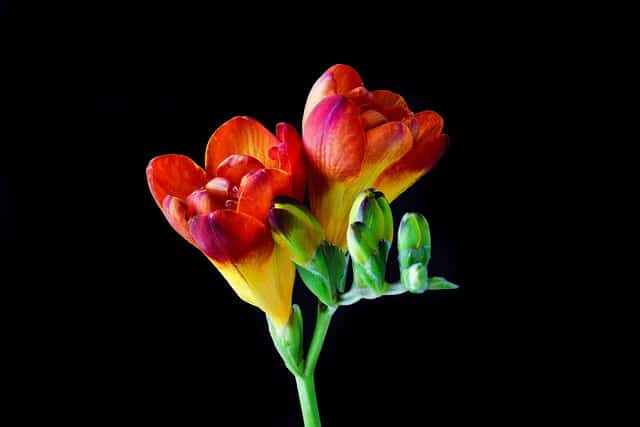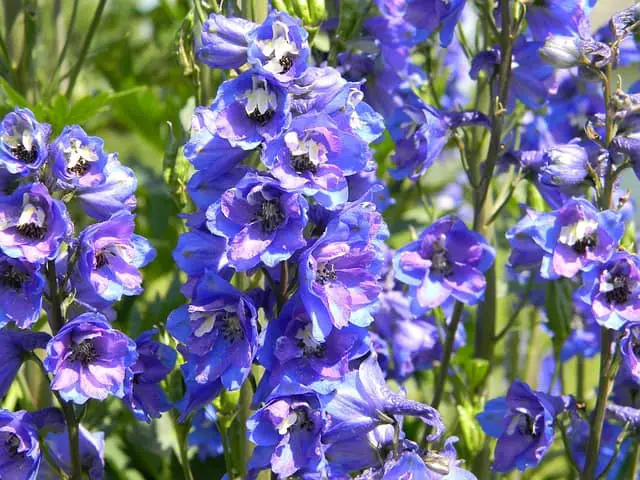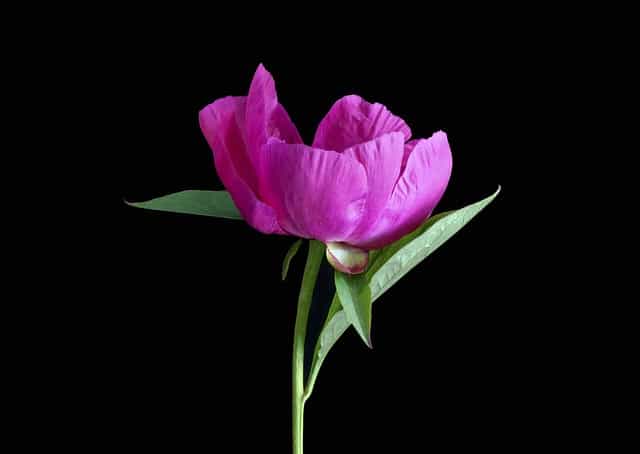Popular for its colorful flowers and sword-like stem, gladiolus is one of the plants that makes a garden stand out. Despite its unique features, there are still several flowers that look like gladiolus.
From summer until frost, the gladioli plant displays attractive flowers in orange, white, purple, red, and pink. So if you’re considering adorning your garden with a wide range of eye-catching flowers, consider gladiolus and its look-alikes. Better still, you can make gladiolus flower garden companions for these similar plants.
In this article, we will discuss the 8 flowers that share some similar features with Gladiolus. Keep reading to find out!
Flowers That Look Like Gladiolus
- Alcea (Hollyhock)
- Freesias (Freesia)
- Hibiscus (Hibiscus)
- Delphinium (Larkspur)
- Crocosmia (Coppertips)
- Pale Yellow-Eyed Grass (Sisyrinchium striatum)
- Peonies (Peony)
- Zinnias (Zinnia)
Now, let’s discuss these plants one after the other.
Also see these other similar posts:
- Weeds That Look Like St Augustine Grass
- Weeds That Look Like Clover With Yellow Flowers
- Plants That Look Like Cucumbers
- Weeds That Look Like Elderberry
1. Alcea (Hollyhock)

One of the plants that are easy to confuse with gladiolus is algae or hollyhocks. Native to Asia and Europe, hollyhocks are more than 60 different species. Mature plants can reach a height of 8 feet when the conditions are favorable for them.
While there are annual and biennial species, some hollyhock plants are perennial. Usually, the petals are over 3 cm wide and can come in yellow, pink, white, or purple.
Considering the flowers’ arrangement on the hollyhock stem, it is easy to assume it is a gladiolus plant. Both plants require bright sunlight, well-drained soil, and high levels of nutrients to thrive.
Most of the time, hollyhocks are mainly used for ornamental purposes due to their colorful flowers. And they’re also highly attractive to butterflies and hummingbirds, especially the species with red flowers.
In certain places, the hollyhock roots are used for medicinal purposes while the stems are useful for firewood.
2. Freesia (Freesia)

Native to South Africa, Freesia is a perennial plant that produces sweet-smelling funnel-shaped flowers. It belongs to the Iridaceae family and was named after Friedrich Ecklon, a German botanist.
Mature freesias grow up to about 30 to 60 cm in height and produce five to seven flowers per stem, which points to a single direction. Similar to gladioli, these flowers can come in yellow, purple, orange, blue, red, or white.
Not only are the flowers used for floral arrangements, but they are also useful in the production of hand creams, shampoos, and more due to their fragrance.
While freesias thrive under bright sunlight, they will do well in a place with some shade. They also need well-drained soil, rich soil to grow perfectly.
3. Hibiscus (Hibiscus)

Another plant that shares a resemblance to gladiolus is the popular hibiscus. These plants are native to warm climates, including tropical and subtropical regions in different parts of the world. With more than 200 species, the hibiscus plant is more popular for its flowers which range from yellow to orange, pink, and red.
When mature, the hibiscus flowers can reach up to 10 inches in diameter.
Like gladioli, the hibiscus stems that protrude out from the center with their tops filled with nectar. And they also require full sunlight and well-drained soil to thrive.
Most species of hibiscus plants are highly attractive to butterflies, hummingbirds, and bees. In addition to being useful for ornamental purposes, some species of hibiscus are also used for making beverages, food, paper, and medicine.
4. Delphinium (Larkspur)

Often planted for their attractive summer flowers of pink, white, purple, and blue, delphiniums are popular among plant lovers. These plants also share certain similarities with gladiolus.
Most species of delphinium are grown for ornamental purposes with lilies and roses as companion plants. Comprising over 300 species, delphiniums are native to the mountains of tropical Africa and the Northern Hemisphere. Some of the plant species are annual and biennial, while others are perennial.
Depending on the species, the delphinium’s flowering stem can be around 10cm to 2m tall. From late spring to late summer, the plants produce colorful flowers that attract bumble bees, butterflies, and some pollinators.
Delphiniums do not grow well in full sunlight or extremely dry climates. Despite their attractive features, these plants are toxic to humans and animals if ingested.
5. Crocosmia (Coppertips)

Crocosmia, commonly known as montbretia or coppertips, are other flowering plants that look just like gladiolus. They grow from underground corms and can be deciduous or evergreen perennials. Crocosmia plants produce beautiful orange, yellow, or red flowers that attract butterflies and hummingbirds.
Although the crocosmia plant is native to South Africa, it is grown in different parts of the world. When mature, crocosmia plants can reach up to 2 to 3 feet in height. These plants grow best in full sunlight and mild temperatures. They also need regular watering and well-drained soil to survive.
In places including the UK, Australia, Ireland, North Carolina, and New Zealand, certain crocosmias hybrids are considered invasive.
6. Pale Yellow-Eyed Grass (Sisyrinchium striatum)

Pale yellow-eyed grass is a perennial plant that shares a resemblance with gladiolus in the way its stems and flowers grow. But compared to gladiolus, this plant only produces white and yellow flowers.
Also known as the satin flower, this pale yellow-eyed grass has grey-green, sword-like leaves. Mature plants can grow up to 70-90 cm in height.
Native to Argentina and Chile, Sisyrinchium striatum prefers bright sunlight and moist, well-draining soil. Even though these plants are not as colorful as gladiolus, they make an excellent addition to gardens.
7. Peonies (Peony)

Native to Asia and Europe, peonies are perennial flowering plants that produce gorgeous flowers similar to gladiolus. They’re hardy and can live for a long time, with some species living up to 100 years. Peonies are classified into three types: tree peonies, herbaceous peonies, and Itoh or intersectional hybrids.
Under favorable conditions, the tree peony can grow up to 4–7 feet tall and 4–5 feet wide. On the other hand, the intersectional hybrid and herbaceous species can reach a height of 1–3 feet.
From late spring to early summer, these plants produce scented flowers in colors ranging from white to yellow, purple, pink, red, and maroon.
Peonies were used in the treatment of certain illnesses in Japan, in addition to their ornamental value due to their colorful and sweet-smelling flowers. Regardless of the species, peonies need full sun and moist, well-draining, rich soil.
8. Zinnias (Zinnia)

Named after the German botany professor Johann Gottfried Zinn, Zinnias is a gorgeous, annual plant that looks like a gladiolus. Native to South America and North America, Zinnias are fast-growing, low-maintenance plants.
From late spring through fall, Zinnias produce flowers that can be orange, yellow, pink, purple, red, green, and white. Zinnias will thrive in full sun and moderate water but may die when constantly exposed to frost.
Due to their different colors and shapes, Zinnias make a good addition to garden flowers. They’re also attractive to butterflies and hummingbirds. Since Zinnias can attract hummingbirds, some gardeners use them as companion plants to ward off whiteflies.
Final Thoughts
When planning to create an impressive garden landscape, go for flowers that look like gladiolus. But before you grow these plants, find out their requirements to care for them better.
Constant maintenance will prevent these gorgeous flowers from losing their beauty. For a start, pay attention to their light, water, soil, temperature, and humidity requirements.
Frequently Asked Questions
What is the Difference between Gladiolus and Hollyhocks?
Even though gladiolus and hollyhocks produce similarly lovely flowers, they are different. In terms of color, gladiolus is usually more flashy and bright. In addition, gladiolus’ leaves are narrow, grooved, and sword-shaped, while hollyhocks have heart-shaped leaves.
What are Small Gladioli Called?
Small or miniature gladiolus (Nanus gladiolus) are called dwarf gladioli. They are usually smaller and shorter than the regular gladiolus varieties. In addition to being as perfect as cut flowers, dwarf gladioli are highly attractive to beneficial insects.
When the conditions are right, it’s not hard to grow and take care of mini gladiolus. As of now, there are over 260 species of dwarf gladiolus. They produce attractive bi-color flowers of pink and white.
How Many Times Will Gladiolus Bloom?
Usually, gladioli produce flowers only once in a season, for a week to three weeks. However, this mainly depends on the plant variety. Therefore, it is advisable to plant a few bulbs every two to three weeks in late spring to early summer.
Most of the time, large bulbs produce flowers in the first year since they’re mature and more robust. Therefore, choose healthier and bigger gladiolus bulbs if you want the plant to flower in the first year after planting.

Hey, I’m Lisa and I’ve been an avid gardener for over 30 years. I love writing, talking and living in the garden! Feel free to connect with me on my socials below

